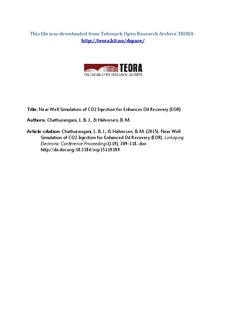| dc.contributor.author | Chathurangani, L.B.J. | |
| dc.contributor.author | Halvorsen, Britt | |
| dc.date.accessioned | 2016-03-10T14:10:33Z | |
| dc.date.accessioned | 2017-04-19T12:52:48Z | |
| dc.date.available | 2016-03-10T14:10:33Z | |
| dc.date.available | 2017-04-19T12:52:48Z | |
| dc.date.issued | 2015-11-25 | |
| dc.identifier.citation | Chathurangani, L. B. J., & Halvorsen, B. M. (2015). Near Well Simulation of CO2 Injection for Enhanced Oil Recovery (EOR). Paper presented at the 56th Conference on Simulation and Modelling (SIMS 56), October, 7-9, 2015, Linköping University, Sweden. | |
| dc.identifier.issn | 1650-3686 | |
| dc.identifier.uri | http://hdl.handle.net/11250/2438598 | |
| dc.description.abstract | A major challenge in oil industry is the declining oil production and the relatively low recovery rate. Estimates show that although the oil is localized and mobile, more than half of the oil is remaining in the reservoir after shut down. There are therefore strong incentives for using CO2 injection for Enhanced Oil Recovery (EOR) for mature oil reservoirs with significant volume of residual oil. Injection of CO2 to reservoirs can also solve the demand for CO2 storage and contribute to reduce the emission of greenhouse gases. In general CO2 is injected to the reservoir as a supercritical fluid which has mobility similar to a gas but density similar to a liquid. Therefore supercritical CO2 behaves as an effective solvent for many oils. Miscible CO2 flooding can be performed for oil having lower viscosities which is capable of increasing the oil mobility. Generally CO2 is not miscible with crude oil on first contact. But at sufficiently high pressures and temperatures, it achieves miscibility with oil. The minimum pressure at which CO2 and oil are completely mixed with each other at any proportion is called as the minimum miscibility pressure (MMP). When reservoir oil contacts the injected CO2, the oil begins to dissolve into the dense CO2 phase and the dense CO2 begins to dissolve into the oil phase. Eventually the oil and the injected CO2 become a single phase due to repeated contacts with time. Dissolving CO2 in oil leads to interfacial tension reduction and promotes more oil recovery. CO2 also causes oil swelling and due to that trapped oil droplets move out of the rock pores and move towards the production wells. Oil viscosity reduction is another advantage of CO2 flooding and the amount of reduction is more significant in high viscous oils. Due to the acid effect on the rock formation as a result of CO2 flooding, reservoir properties such as porosity and permeability can be altered. In this work near well simulations have been performed using the software Rocx in combination with OLGA. The relative permeability is essential in simulations of oil reservoirs. When CO2 is injected to the reservoir, the relative permeability and the residual oil saturation change. The relative permeability is given as input to Rocx. A better understanding of reservoir conditions when CO2 is injected to the reservoir is needed. Near well simulations have been performed with CO2 injection and without CO2 injection to study the increase in oil recovery. Different permeability curves and residual oil saturations have been included for the two cases, and the results show clearly that additional oil can be produced by performing CO2-EOR. | |
| dc.language.iso | eng | |
| dc.publisher | Linköping University Electronic Press | |
| dc.subject | Enhanced oil recovery | |
| dc.subject | OLGA simulation | |
| dc.subject | miscible CO2 flood | |
| dc.subject | relative permeability | |
| dc.title | Near Well Simulation of CO2 Injection for Enhanced Oil Recovery (EOR) | |
| dc.type | Journal article | |
| dc.type | Peer reviewed | |
| dc.description.version | Published version | |
| dc.subject.nsi | 610 | |
| dc.source.journal | Linköping Electronic Conference Proceedings | |
| dc.identifier.doi | http://doi.org/10.3384/ecp15119309 | |
